Red & BBs retirement home......
- Thread starter British Red
- Start date
-
Come along to the amazing Summer Moot (21st July - 2nd August), a festival of bushcrafting and camping in a beautiful woodland PLEASE CLICK HERE for more information.
You are using an out of date browser. It may not display this or other websites correctly.
You should upgrade or use an alternative browser.
You should upgrade or use an alternative browser.
Not tried Pecan's mate
We are going for sweet chestnuts and cobnuts (like big hazel nuts). Walnuts do well here (my neighbours have several), but they aren't my favourite to be honest
Red
We are going for sweet chestnuts and cobnuts (like big hazel nuts). Walnuts do well here (my neighbours have several), but they aren't my favourite to be honest
Red
Interesting to calculate the rainwater harvesting rate....
Here is the tank today
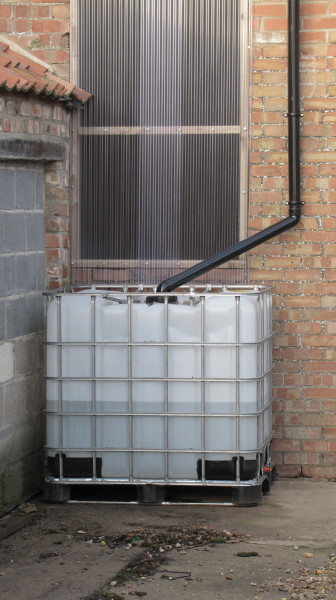
Rainwater harvesting by British Red, on Flickr
That is harvesting from half a barn roof (we have three barns)
I figure that to be about 300 litres in six days.....50 litres a day. So, if we extend that to both sides of three roofs....300 litres a day
Red
Here is the tank today

Rainwater harvesting by British Red, on Flickr
That is harvesting from half a barn roof (we have three barns)
I figure that to be about 300 litres in six days.....50 litres a day. So, if we extend that to both sides of three roofs....300 litres a day
Red
A thought Red.....If you raised the tanks off the ground by a meter or so things would work by gravity....
Our big, riveted iron, Victorian tank is about 5' off the ground and works the loo and outside tap. The disadvantage to above ground tanks, as opposed to underground units, is freezing. But in my opinion, this is outweighed by the fact that no pump is needed for most jobs.
Swyn.
PS our tank equates to about 5 of these 1000litre cubes.
PPS. in summer and in particular during the last two dry spells we took to putting one cube on the front loader of the tractor and driving slowly down the hedge line with the valve open fully. This worked well and we only lost ten of the plantlets!
S
Our big, riveted iron, Victorian tank is about 5' off the ground and works the loo and outside tap. The disadvantage to above ground tanks, as opposed to underground units, is freezing. But in my opinion, this is outweighed by the fact that no pump is needed for most jobs.
Swyn.
PS our tank equates to about 5 of these 1000litre cubes.
PPS. in summer and in particular during the last two dry spells we took to putting one cube on the front loader of the tractor and driving slowly down the hedge line with the valve open fully. This worked well and we only lost ten of the plantlets!
S
Last edited:
I have thought about it. We have a 2,000 litre underground brick build cistern fed from the house roof and a well as well.
My plan for these tanks is to use my Hozelock pump
The new well head we put in accepts it
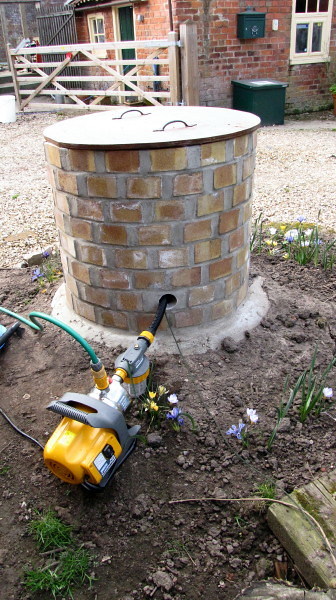
Well pump by British Red, on Flickr
and I have set up the IBC tanks for hozelock (to daisy chain)
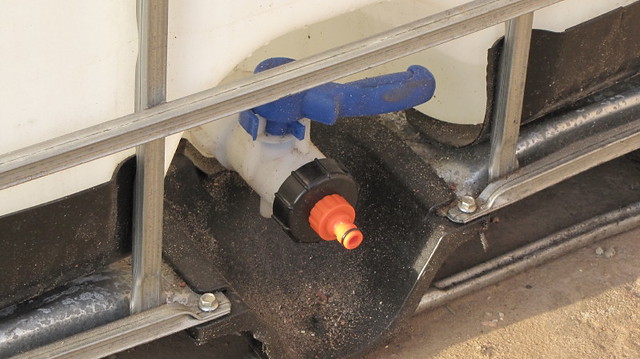
IBC Hozelock Adapter by British Red, on Flickr
That said, jacking up the tanks would let me gracvity feed a trickle feed system.
Just need to think of a cheap way to do it!
Red
My plan for these tanks is to use my Hozelock pump
The new well head we put in accepts it

Well pump by British Red, on Flickr
and I have set up the IBC tanks for hozelock (to daisy chain)

IBC Hozelock Adapter by British Red, on Flickr
That said, jacking up the tanks would let me gracvity feed a trickle feed system.
Just need to think of a cheap way to do it!
Red
Ah, yes, Red....I've forgotton about that one!
We have no underground system as yet, simply because the old system works well. The only extra so far was to dig a pond for the garden and wildlife. The spoils were used for a play area for my wife's ponies as they like to play 'lookout'
The pond is a magnet for all sorts.
Swyn.
We have no underground system as yet, simply because the old system works well. The only extra so far was to dig a pond for the garden and wildlife. The spoils were used for a play area for my wife's ponies as they like to play 'lookout'
The pond is a magnet for all sorts.
Swyn.
We watched what the surface water did during our first winter here. The winter of 1998 was one of the wettest so that watching was the only positive bit of wading through the mud that surrounded most of this smallholding at the time! An abandoned farm is no place to be for a first winter in a wet time, nothing works, the drains don't work, the roofs leak, etc! The learning curve was very steep!
The watching left us with no indecision as to where the pond would be. The area was duly marked out using two lengths of hosepipe to show the outline of the edge. I had in my minds eye a shape that would allow a view from one particular window and the yellow hose was a good marker not affected by the wind like string. I allowed too for oversizing to cater for the eventual water area as the slope of the sides are governed by the local soil conditions, that is unless you have porous soil in which case a liner in plastic or clay will be needed. In our case the water table is quite high and can be helped by 'pugging' the clay from a certain level. In the past cattle were run about in the excavations, straw was added and the resulting mush used for building...but I digress.
The resulting hole is about eight feet into the ground and roughly 40'x30' in size and the water is holding in the sump part 2' deep in a 20' circle. When the rains fill the ditches again the water will fill to within 1' of the top which is lovely to see.
I have one alteration to do this spring which is to grade the end facing our house a little more. Doing this will mean an improved view down into the lowest water level and thus the creatures visiting. I could not do this at first because I had no idea how the water would lay being the first time such a hole had been dug in this area! All other ponds that I have been involved with have been very old and in need of dredging so this has been an interesting learning curve. This slope too would have probably been created by the oxen/cattle, oxing the straw/coming in to drink over centuries.
Swyn.
The watching left us with no indecision as to where the pond would be. The area was duly marked out using two lengths of hosepipe to show the outline of the edge. I had in my minds eye a shape that would allow a view from one particular window and the yellow hose was a good marker not affected by the wind like string. I allowed too for oversizing to cater for the eventual water area as the slope of the sides are governed by the local soil conditions, that is unless you have porous soil in which case a liner in plastic or clay will be needed. In our case the water table is quite high and can be helped by 'pugging' the clay from a certain level. In the past cattle were run about in the excavations, straw was added and the resulting mush used for building...but I digress.
The resulting hole is about eight feet into the ground and roughly 40'x30' in size and the water is holding in the sump part 2' deep in a 20' circle. When the rains fill the ditches again the water will fill to within 1' of the top which is lovely to see.
I have one alteration to do this spring which is to grade the end facing our house a little more. Doing this will mean an improved view down into the lowest water level and thus the creatures visiting. I could not do this at first because I had no idea how the water would lay being the first time such a hole had been dug in this area! All other ponds that I have been involved with have been very old and in need of dredging so this has been an interesting learning curve. This slope too would have probably been created by the oxen/cattle, oxing the straw/coming in to drink over centuries.
Swyn.
I don't have the land for anyhting that impressive in scale sadly....but a little spot for frogs and dragon flies will please me 
A small update on the rainwater harvesting system
The first tank went in in Early December. Within a fortnight it was overflowing!

Rainwater harvesting by British Red, on Flickr
So a larger capacity was clearly warranted
Four more IBC tanks arrived this week
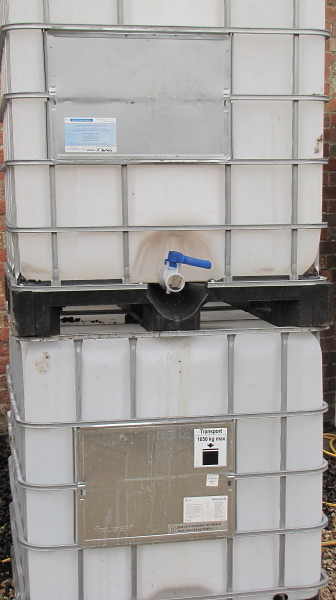
IBC Tanks by British Red, on Flickr
To connect them all up I decided on a fairly "Heath Robinson" approach. These tanks are currently aimed at use for crop watering - so compatability with a hose sytem seemed vital. Here is how we did it
First we lined up all the tanks with tap outward
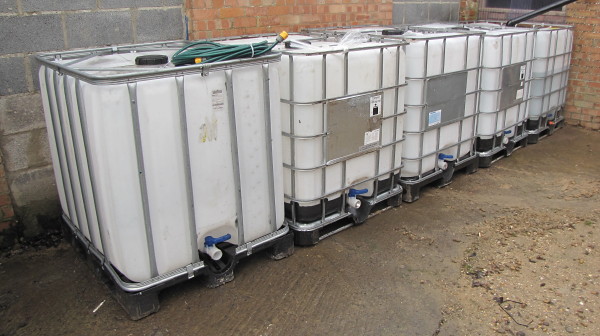
IBC Tanks in place by British Red, on Flickr
If you see the bottom of each tank there is a threaded outlet

IBC Tank Threaded tap by British Red, on Flickr
You can get standard 60mm blanking plates for these, they can be drilled and a standard hozelock adaptor put in
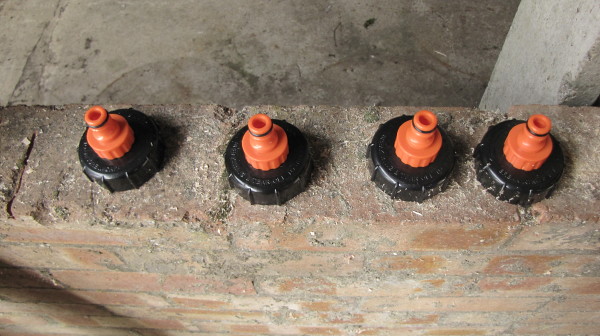
IBC Hozelock Adapters by British Red, on Flickr
When connecting these, I have found it useful to grease the washers and thread with petroleum jelly (Vaseline) to get a good seal
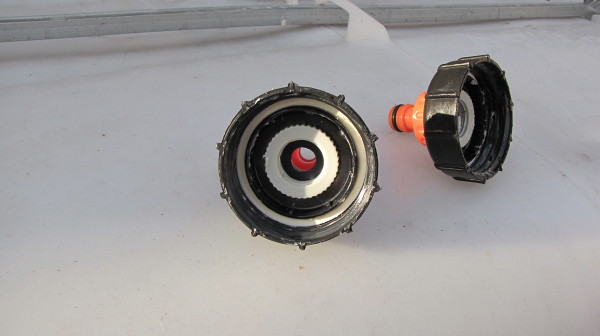
Greasing the washers and threads by British Red, on Flickr
Now I could just daisy chain the tanks, but I want to able to empty individual tanks for cleaning etc. So I bought a four way adaptor with taps on each spur.
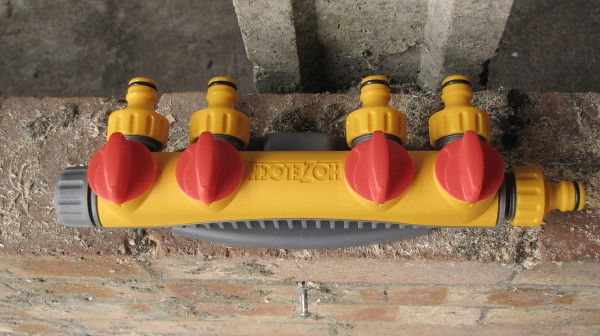
Hozelock 4 way splitter by British Red, on Flickr
This was attached to the tank filled by the downspout
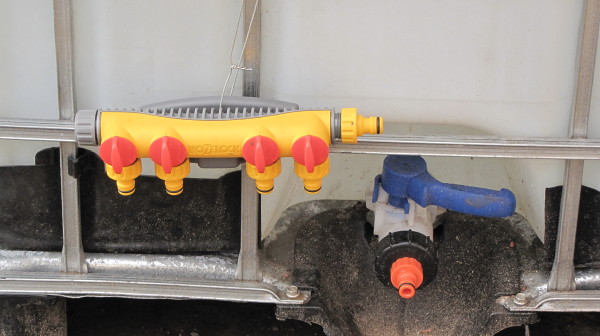
Tap with adaptor and splitter by British Red, on Flickr
The "primary" tank is connected to the splitter

Splitter connected to tap by British Red, on Flickr
Each subsequent tank is connected to a spur by a length of hose (with a hozelock connector at each end)
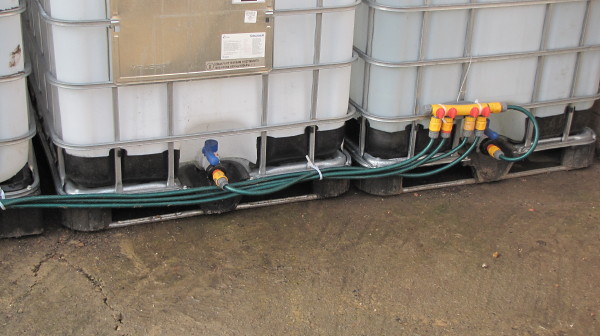
Connecting up the master tank by British Red, on Flickr
The whole lot together looks like this

Completed rainwater system by British Red, on Flickr
To make it work, open the main blue tap on the primary tank. Then to "cross flow" to another tank, open the relevant red tap on the splitter and blue tap on the required tank. If all the blue tank taps and red splitter taps are opened, all five tanks fill at the same rate.
To use water from a tank, close thre relevant red tap on the splitter (to stop the primary tank filling it), close the blue tank tap (to prevent wet feet). Then disconnect the hose from that tank. Either use gravity to feed a trickle hoze or connect up a hozelock compatible pump

Well pump by British Red, on Flickr
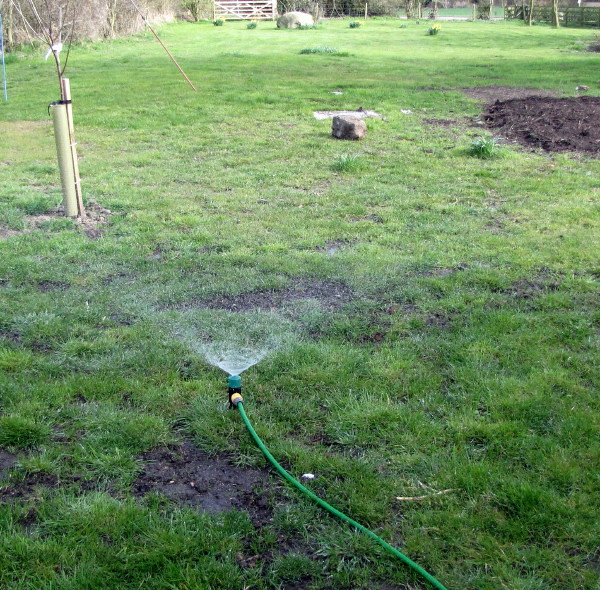
well pump sprinkler by British Red, on Flickr
With our "steading" of barns, I think I can comfortably get up to a dozen tanks or more and keep them full
Red
The first tank went in in Early December. Within a fortnight it was overflowing!

Rainwater harvesting by British Red, on Flickr
So a larger capacity was clearly warranted
Four more IBC tanks arrived this week

IBC Tanks by British Red, on Flickr
To connect them all up I decided on a fairly "Heath Robinson" approach. These tanks are currently aimed at use for crop watering - so compatability with a hose sytem seemed vital. Here is how we did it
First we lined up all the tanks with tap outward

IBC Tanks in place by British Red, on Flickr
If you see the bottom of each tank there is a threaded outlet

IBC Tank Threaded tap by British Red, on Flickr
You can get standard 60mm blanking plates for these, they can be drilled and a standard hozelock adaptor put in

IBC Hozelock Adapters by British Red, on Flickr
When connecting these, I have found it useful to grease the washers and thread with petroleum jelly (Vaseline) to get a good seal

Greasing the washers and threads by British Red, on Flickr
Now I could just daisy chain the tanks, but I want to able to empty individual tanks for cleaning etc. So I bought a four way adaptor with taps on each spur.

Hozelock 4 way splitter by British Red, on Flickr
This was attached to the tank filled by the downspout

Tap with adaptor and splitter by British Red, on Flickr
The "primary" tank is connected to the splitter

Splitter connected to tap by British Red, on Flickr
Each subsequent tank is connected to a spur by a length of hose (with a hozelock connector at each end)

Connecting up the master tank by British Red, on Flickr
The whole lot together looks like this

Completed rainwater system by British Red, on Flickr
To make it work, open the main blue tap on the primary tank. Then to "cross flow" to another tank, open the relevant red tap on the splitter and blue tap on the required tank. If all the blue tank taps and red splitter taps are opened, all five tanks fill at the same rate.
To use water from a tank, close thre relevant red tap on the splitter (to stop the primary tank filling it), close the blue tank tap (to prevent wet feet). Then disconnect the hose from that tank. Either use gravity to feed a trickle hoze or connect up a hozelock compatible pump

Well pump by British Red, on Flickr

well pump sprinkler by British Red, on Flickr
With our "steading" of barns, I think I can comfortably get up to a dozen tanks or more and keep them full
Red
Its time to wake it all up again after Winter
Is it odd to find beauty in the dark soil of freshly manured ground?

Freshly manured beds by British Red, on Flickr
The over wintered garlic and onions are off to a flying start
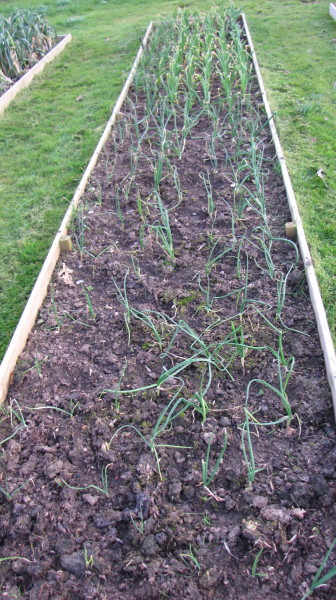
Over wintered onions and garlic by British Red, on Flickr
We've been eating spring onions (salad onions) all Winter - they survived temperatures down to -12C :shock: . They are flowering now and I plan to seed save some - winter fresh greens are great!
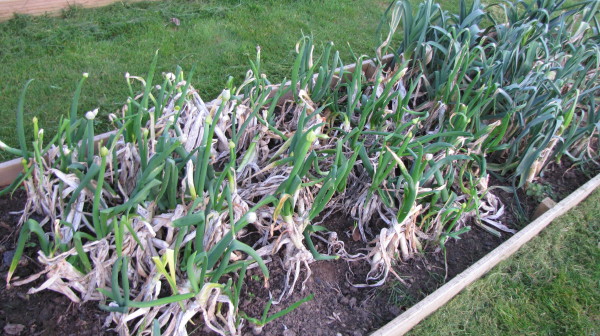
Salad onions and leeks by British Red, on Flickr
Some of the heirloom parsnips have been left - I hope they will flower for seed saving
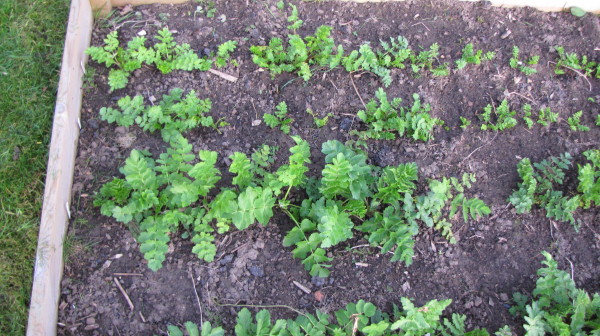
Left over parnsnips for seed by British Red, on Flickr
The new hedge is leafing up - I was worried it might not take as the winter has been so dry - happy now

New hedge in leaf by British Red, on Flickr
The manure heap is much denuded now!

Manure nearly gone by British Red, on Flickr
The new fruit trees are budding nicely
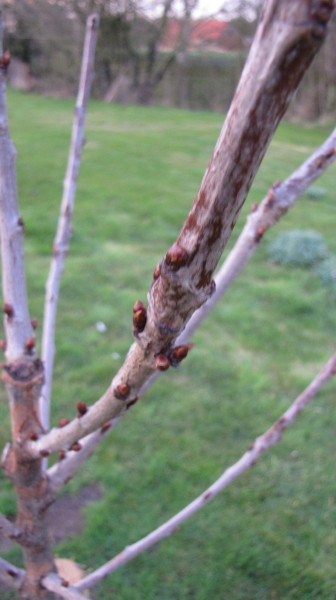
New tree bud by British Red, on Flickr
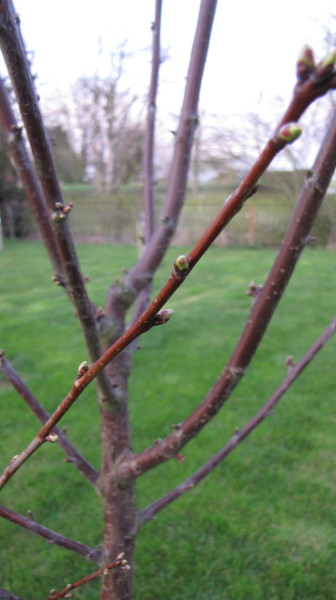
New trees budding by British Red, on Flickr
Seeds are all sorted into month packs in the seed cabinet - time to get em going now!
More will follow
Red
Is it odd to find beauty in the dark soil of freshly manured ground?

Freshly manured beds by British Red, on Flickr
The over wintered garlic and onions are off to a flying start

Over wintered onions and garlic by British Red, on Flickr
We've been eating spring onions (salad onions) all Winter - they survived temperatures down to -12C :shock: . They are flowering now and I plan to seed save some - winter fresh greens are great!

Salad onions and leeks by British Red, on Flickr
Some of the heirloom parsnips have been left - I hope they will flower for seed saving

Left over parnsnips for seed by British Red, on Flickr
The new hedge is leafing up - I was worried it might not take as the winter has been so dry - happy now

New hedge in leaf by British Red, on Flickr
The manure heap is much denuded now!

Manure nearly gone by British Red, on Flickr
The new fruit trees are budding nicely

New tree bud by British Red, on Flickr

New trees budding by British Red, on Flickr
Seeds are all sorted into month packs in the seed cabinet - time to get em going now!
More will follow
Red
nice job Red
WE have finally got the garden fenced off into areas
HAvent got my IBCs installed yet probably going to fit a large bore syphon so tehy fill together then asa they are higher i can pipe it by gravity to the veg beds
Timber to make up 10off 8ft x 4ft raised beds arrives this week
and Sarah finally got in her Drysuit for the first time in years thisafternoon so we could start clearing the weed out of the pond
AATB
Duncan
WE have finally got the garden fenced off into areas
HAvent got my IBCs installed yet probably going to fit a large bore syphon so tehy fill together then asa they are higher i can pipe it by gravity to the veg beds
Timber to make up 10off 8ft x 4ft raised beds arrives this week
and Sarah finally got in her Drysuit for the first time in years thisafternoon so we could start clearing the weed out of the pond
AATB
Duncan
Very cool Dunc - say hi to Sarah and the saplings for me?
Love to see piccs of your place as it develops!
Love to see piccs of your place as it develops!
yes its time for mor pics we will have been in 1 yr at teh end of the monthVery cool Dunc - say hi to Sarah and the saplings for me?
Love to see piccs of your place as it develops!
your welcome to stay if you ever come this way we have a spare room with log burner
ATB
Duncan
Well, here is a bit abut what we have been up to
One of this year's ecperiments is "Oca"
We are trying two types - red and orange. They chit just like potatoes
This is red
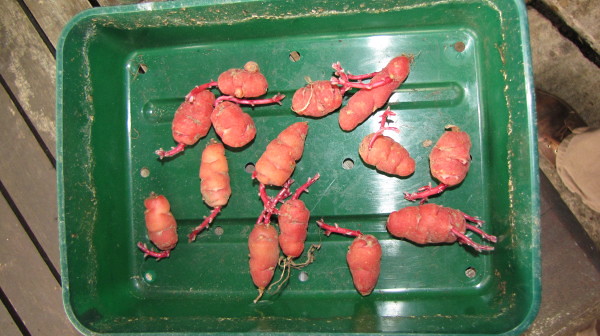
Red oca by British Red, on Flickr
This is the orange type
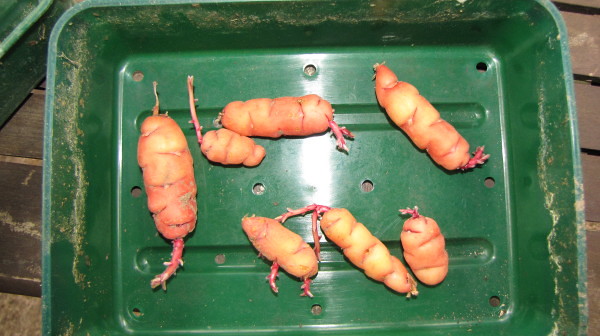
Orange Oca by British Red, on Flickr
This is the bed we plan to use - 21 tubers gets us about a third of a bed (35 square feet). This bed has been deep manured and rotovated twice - it should be very fertile

Prepared bed by British Red, on Flickr
This shows my short and long measures. Basically lengths of 2x2. One side is marked up in 12" marks, another at 18", another at 9" and another at 6". Laying them on the soil at right angles gets me the right plant gaps (as an example for spuds 24" between rows, 9" between plants). Its quick, its obvious and it helps keep things even
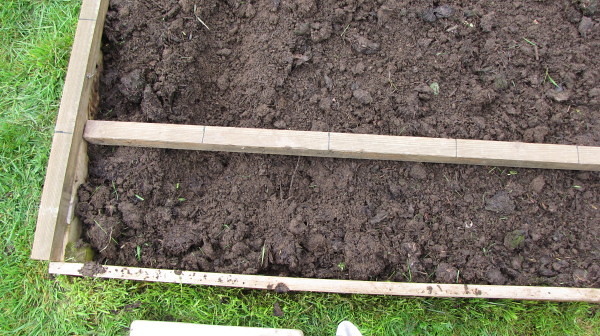
Layout poles by British Red, on Flickr
Depending on the crop, a scrape with a trowel or drag with a draw hoe sets things up
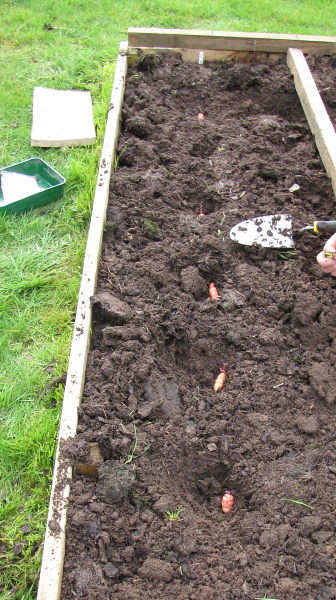
Planted oca by British Red, on Flickr
This is another technique we find useful - a seed filing system (our seed bank) with dividers for each month. When we have a planting day, all the right seeds are to hand
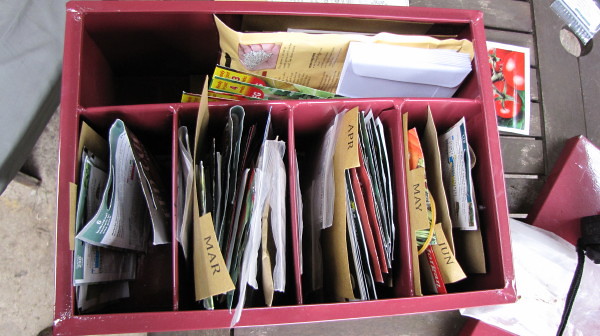
Seed bank by British Red, on Flickr
We are slowly converting to entirely "self produced" seed - starting from Heritage varieties from real seeds and premier seeds direct
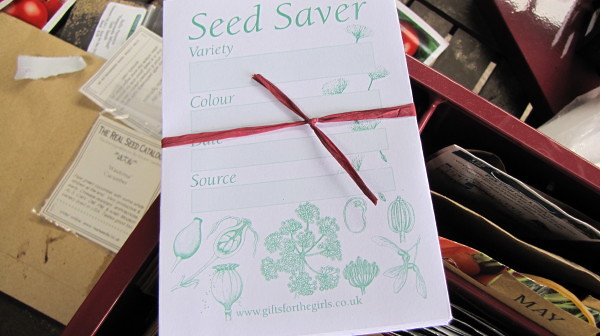
seed saving envelopes by British Red, on Flickr
We are also trying sugar beet this year. Storage is all very well but sugar is a vital preserving item - so we must be able to make it

Sugar beet by British Red, on Flickr
We kicked off the first of the tomatoes today
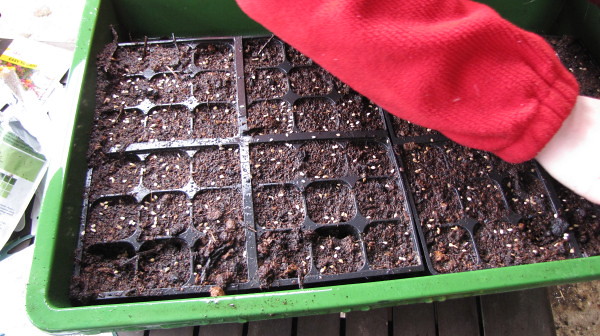
Tomatoes by British Red, on Flickr
We also started two varieties of chillies in these propogators - I love these as they are sized to sit on a windowsill in the house

Window sill propogators by British Red, on Flickr
The less temperature sensitive stuff is in the cool grennhouse to start it off

Seed trays and staging by British Red, on Flickr
The other greenhouse has strawberry runners, rosemary and lavender ready for planting out and some Yacon I was given that I ahve my fingers crossed has survived the frost
More as the season moves on
Red
One of this year's ecperiments is "Oca"
Realseeds.co.uk said:"OCA" (Latin name: Oxalis Tuberosa) ~
This is a favourite of ours from South America. Oca is grown and used just like new potatoes, although they are smaller than potatoes. It has a lemony taste and is very easy to grow as long as you have a moderately long season. It is completely unrelated to potatoes and so of course not affected by blight.
One of the 'Lost Crops' of the Incas, this is one of the staples of people in Bolivia & Peru. A very easy crop to grow, with a taste just like potatoes with lemon sauce. No need to peel, just boil and serve with butter. Mmmmm.
And the lush green foliage with yellow flowers is actually rather pretty in its own right. Very few pests seem to like it, so its a real 'no work' crop.
The tubers start to form in short days, usually in mid November, so if you have early frosts this is not for you.
On the other hand, if the autumn is mild, as it has been this year, you should get a big crop of surprisingly large tubers. We got about 1/2 a kilo of Oca from each tuber planted.
We have grown it successfully for years: both in Cambridge and on the west coast of Wales, but we don't know how it would fare further north. It is very easy to multiply up - you just keep a few tubers back for replanting. So if you like it you don't need to buy it each year but just replant your own.
We are trying two types - red and orange. They chit just like potatoes
This is red

Red oca by British Red, on Flickr
This is the orange type

Orange Oca by British Red, on Flickr
This is the bed we plan to use - 21 tubers gets us about a third of a bed (35 square feet). This bed has been deep manured and rotovated twice - it should be very fertile

Prepared bed by British Red, on Flickr
This shows my short and long measures. Basically lengths of 2x2. One side is marked up in 12" marks, another at 18", another at 9" and another at 6". Laying them on the soil at right angles gets me the right plant gaps (as an example for spuds 24" between rows, 9" between plants). Its quick, its obvious and it helps keep things even

Layout poles by British Red, on Flickr
Depending on the crop, a scrape with a trowel or drag with a draw hoe sets things up

Planted oca by British Red, on Flickr
This is another technique we find useful - a seed filing system (our seed bank) with dividers for each month. When we have a planting day, all the right seeds are to hand

Seed bank by British Red, on Flickr
We are slowly converting to entirely "self produced" seed - starting from Heritage varieties from real seeds and premier seeds direct

seed saving envelopes by British Red, on Flickr
We are also trying sugar beet this year. Storage is all very well but sugar is a vital preserving item - so we must be able to make it

Sugar beet by British Red, on Flickr
We kicked off the first of the tomatoes today

Tomatoes by British Red, on Flickr
We also started two varieties of chillies in these propogators - I love these as they are sized to sit on a windowsill in the house

Window sill propogators by British Red, on Flickr
The less temperature sensitive stuff is in the cool grennhouse to start it off

Seed trays and staging by British Red, on Flickr
The other greenhouse has strawberry runners, rosemary and lavender ready for planting out and some Yacon I was given that I ahve my fingers crossed has survived the frost
More as the season moves on
Red
Looking like you've been really busy in the garden Hugh 
I look forward to seeing each update as it progresses
I look forward to seeing each update as it progresses
I have an IBC as a water butt in the garden. I now wish that I had procured a black one rather than the more common white variety. The sunlight gets through to the water and it first goes green then grows great sheets of black slime which clog up the outlet.
Z
Z
Similar threads
- Replies
- 13
- Views
- 3K
- Replies
- 107
- Views
- 46K
- Replies
- 0
- Views
- 3K
- Replies
- 21
- Views
- 5K
